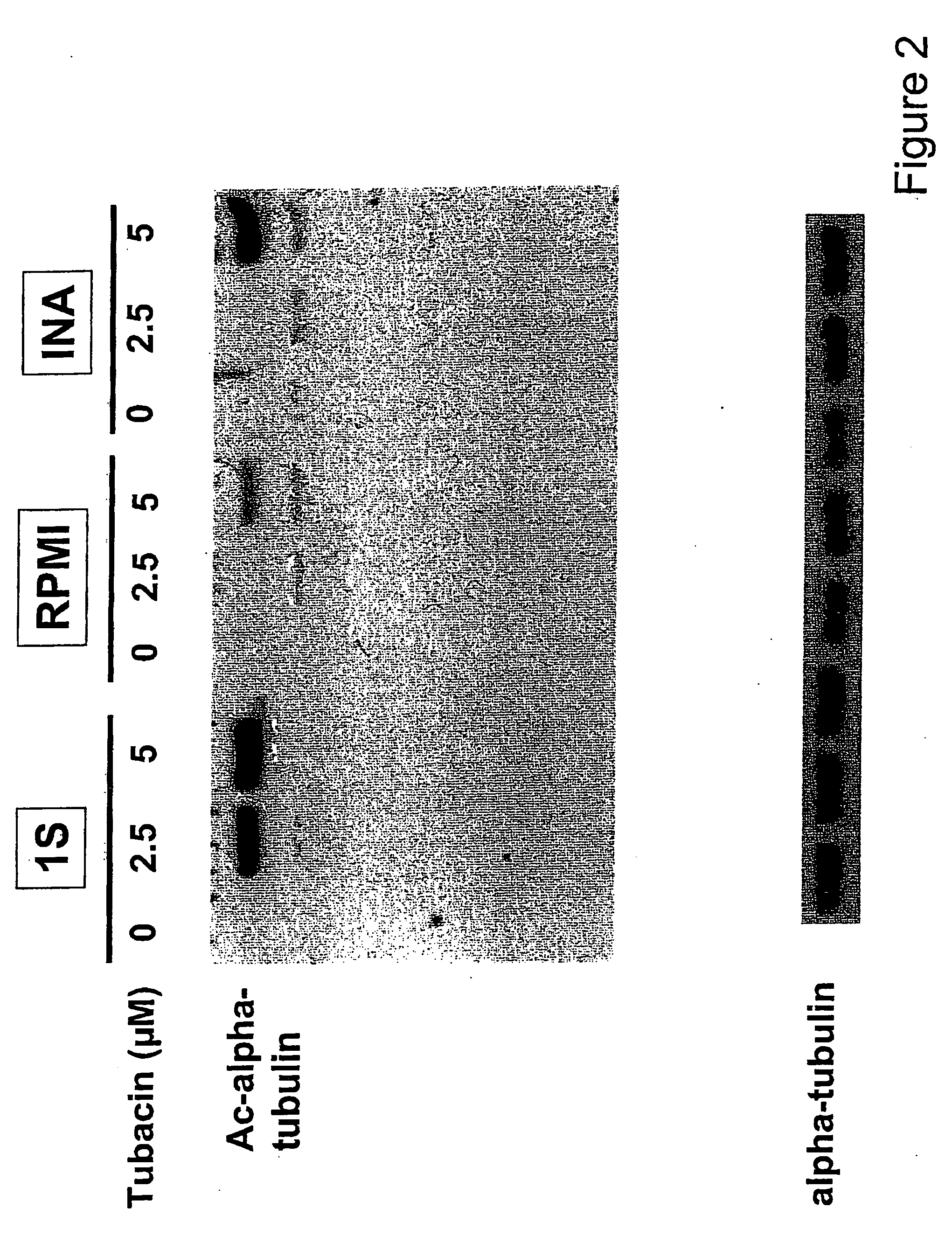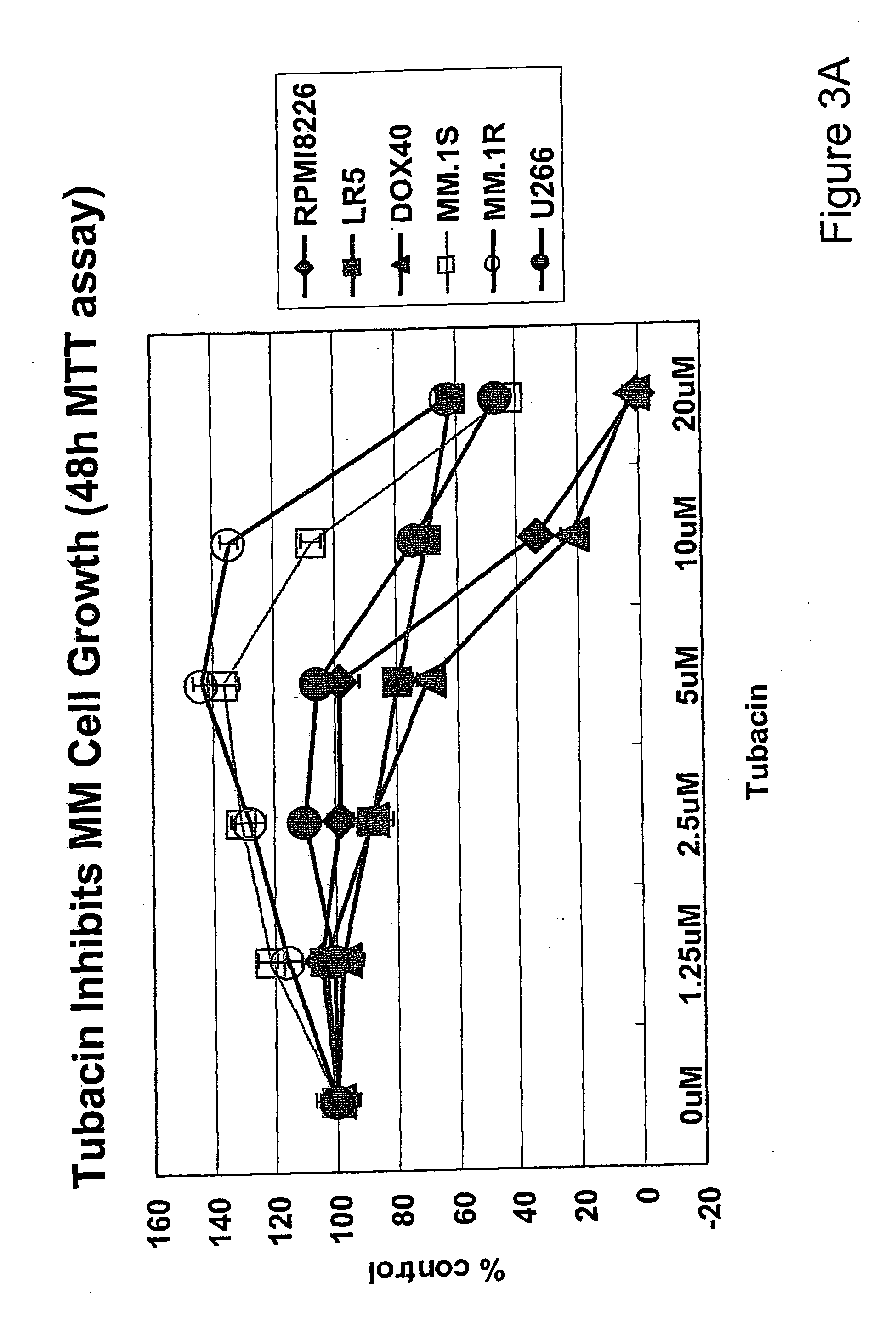Treatment of protein degradation disorders
- Summary
- Abstract
- Description
- Claims
- Application Information
AI Technical Summary
Benefits of technology
Problems solved by technology
Method used
Image
Examples
example 1
Tubacin Specifically Induces Acetylation of α-Tubulin in MM Cell Lines.
[0373] The baseline expression of HDAC6 was examined in several MM cell lines. Although MM.1S, U266, INA-6, RPM18226, and RPMI-LR5 MM cell lines constitutively express HDAC6, only low levels of HDAC6 are evident in RPMI-Dox-40 cells (FIG. 1A). Since tubacin induces acetylation of α-tubulin in A549 human lung cancer cell line by specific inhibition of HDAC6 activity (40), the effect of tubacin was examined on acetylation of α-tubulin in MM.1S and RPM18226 MM cells. As shown in FIG. 1B, tubacin significantly induces aceylation of α-tubulin in a dose-dependent fashion in both MM.1S and RPM18226 cells, without alteration of protein expression; importantly, no other acetylated proteins were recognized by Western blotting. Similar results were observed in INA-6 and RPMI-Dox40 cells (data not shown). The dose-dependent effect of tubacin was assessed, and show that tubacin (5 μM) induces peak acetylation of α-tubulin i...
example 2
Tubacin Inhibits MM Cell Growth.
[0375] Based upon the specific inhibitory effect of tubacin on HDAC6, next examined was the cytotoxicity of tubacin against drug-sensitive (MM.1S, U266, INA-6, and RPM18226) and -resistant (RPMI-LR5 and RPMI-Dox40) MM cell lines. These cells were treated with tubacin (1.25-20 μM) for 48 h (FIG. 2A) and 72 h (FIG. 2B), and cytotoxicity was assessed by MTT assay, as describe. Tubacin significantly inhibits both drug-sensitive and -resistant MM cell growth, with IC50 5-20 μM at 72 h. The most sensitive and resistant cell lines are RPM18226 and MM.1R cells, respectively (FIG. 2B). Importantly, no cytotoxicity in PBMCs is induced by tubacin (FIG. 2C). These results indicate that tubacin sensitivity is independent of resistance to conventional chemotherapeutic agents (dexamethasone, melphalan and doxorubicin) and suggest a favorable therapeutic index in tumor cells versus normal cells. It was shown that HDAC inhibitors SAHA and NVP-LAQ824 trigger MM cell ...
example 3
Tubacin Inhibits Interaction of HDAC6 with Dynein; When Combined with Bortezomib, it Induces Accumulation of Ubiquitinated Proteins.
[0376] To overcome bortezomib resistance in MM, novel therapeutic options are urgently needed. Based upon our preclinical studies showing that bortezomib inhibits DNA repair (29, 31), combined treatment of bortezomib has been shown to sensitize or overcome resistance to DNA damaging agents (i.e., melphalan and doxorubicin) (29). It has also been shown that hsp-27 expression is associated with bortezomib resistance (30, 51); conversely, p38MAPK inhibitors can downregulate hsp-27 in bortezomib resistant MM cell lines and patient cells, and overcome bortezomib resistance. Recent studies have demonstrated that polyubiquitinated proteins are degraded via both proteasome and aggresome pathways (FIG. 3A).
[0377] HDAC6 constitutively binds both polyubiquitinated misfolded proteins and dynein, thereby recruiting misfolded protein cargo to dynein motors for tra...
PUM
| Property | Measurement | Unit |
|---|---|---|
| Biological properties | aaaaa | aaaaa |
| Pharmaceutically acceptable | aaaaa | aaaaa |
| Degradation properties | aaaaa | aaaaa |
Abstract
Description
Claims
Application Information
 Login to View More
Login to View More - R&D
- Intellectual Property
- Life Sciences
- Materials
- Tech Scout
- Unparalleled Data Quality
- Higher Quality Content
- 60% Fewer Hallucinations
Browse by: Latest US Patents, China's latest patents, Technical Efficacy Thesaurus, Application Domain, Technology Topic, Popular Technical Reports.
© 2025 PatSnap. All rights reserved.Legal|Privacy policy|Modern Slavery Act Transparency Statement|Sitemap|About US| Contact US: help@patsnap.com



